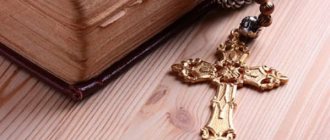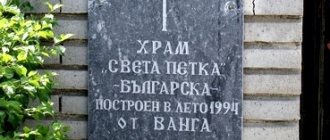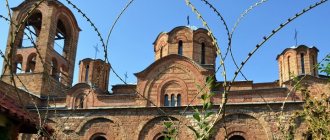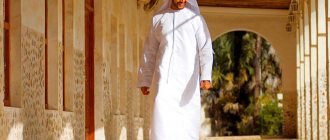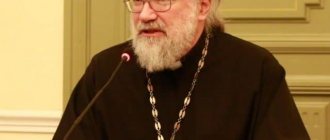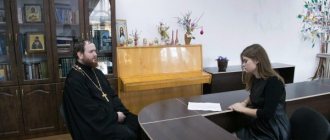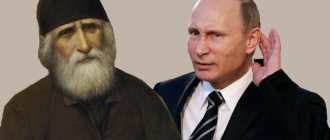Archpriest Vladimir Dolgikh answers.
If one of our fellow citizens is asked to draw a verbal portrait of an Orthodox priest, then he may forget (or not know) about some parts (elements) of the vestment, but no one will forget about the beard. Moreover, the beard will be what he remembers first. The statement that priests wear beards has already become so ingrained in our consciousness that not everyone can answer directly: why priests wear beards. It just so happened, and if someone happens to see a beardless priest in vestments, then one cannot do without slight disorientation and an attack of cognitive dissonance.
So, why do priests wear beards? Many, probably, on reflection, will refer to the image of Jesus Christ, which we see on icons, and will point out that this is how the imitation of the appearance of the Savior is manifested. Of course, this is one of the reasons, but not the only one.
Beard in Scripture
Even those who have not particularly delved into the texts of the Holy Scriptures can guess that the wearing of a beard by priests has ancient Old Testament roots. And indeed, in the 19th and 21st chapters of the Book of Leviticus we will see the direct command of the Lord not to cut our heads and beards. There are reasons for this as well. The non-canonical Epistle of Jeremiah, in the very first chapter, tells us that shaving heads and beards was characteristic of pagan priests, which is why the Mosaic Law was aimed at restraining Jewish priests from idolatrous practices. St. Ephraim the Syrian clarifies that the pagans specially grew hair on their heads and faces, in order to then cut them off at a specially appointed time at “sacred” sources or directly at the temples themselves. Thus, shaving heads and beards was not just a tradition, but part of idolatrous mystery cults. We understand perfectly well that Christ abolished the Old Testament ritual law, therefore in the New Testament we will not find such commands regarding wearing a beard, but there is another side to this issue.
Proper care
Of course, it is very nice to have such decoration. It immediately changes your appearance and creates a new image. However, in order for your hair not to lose its appearance, you need to properly care for it. Some people don’t want to deal with this issue on their own, so they regularly visit barbershops.
If you want to save money, then you will have to correct your hair yourself. It's actually not a hard task. You just need to purchase the necessary tools. These include:
- Scissors,
- Trimmer,
- Stencil,
- Mirror,
- Comb,
- Machine or disposable razor.
You also need to buy detergents and styling gels. You need to adjust the shape of your haircut several times a week. It is important to wash your hair daily to keep it looking well-groomed. Once you learn how to cut your hair correctly, this procedure will not take you much time.
Beard in the canons
In the first book of the “Apostolic Constitutions” (paragraph 4) it is said that he who wants to please others “bares his beard.” Approximately the same idea is heard in the 96th rule of the Sixth Ecumenical Council. It says that those who have put on Christ must imitate His life, and hence avoid weaving and specially styling their hair, with which they tempt fragile souls. Zonara in his interpretation explains that this rule also applies to a beard, but here again there are reasons. At that time, men braided their hair and shaved their beards in order to appear gentle and more like women. As you may have guessed, in this case we are talking about the homosexual traditions of the ancient Roman Empire. In order to distance itself from such associations, the Church introduces a ban on manipulation of hair, which was a sign of prodigal vices.
As we understand, since those times the tradition of wearing a beard has become so ingrained that now priests wear a beard, as modern programmers would say, by default.
Subsequently, the idea of the similarity of a beardless man with a woman migrated to the definitions of the Stoglavy Council (1551). But, apparently, in the 16th century, the absence of a beard on a man seemed so unnatural that the Council’s definitions even contained a ban on funeral services and any other prayers in the church for the repose of the souls of those who dared to shave their beards.
This is probably why the Orthodox beard in Ukraine, Russia, Belarus, in general, in Slavic countries, acquired a semantic connection with such concepts as might, strength, will, and other attributes of masculinity.
Maxim Isaev
Doctor of Law, Professor of the Department of Constitutional Law at MGIMO:
– I’ve had a beard since 2004. I started going with her after I defended my doctorate. We can say that the specifics of my work contributed to the appearance of the beard.
Women don't like beards - they are frivolous! For an Orthodox man, a beard is a certain dignity and meaning of his worldview. Being with a beard, he takes on certain obligations - first of all, to conform to the image of the Lord our God, because the Lord created us in his image. And if we look at the iconography, our Lord Jesus Christ is depicted everywhere with a beard. Therefore, we must strive to conform to Him.
One can recall many historical examples when Orthodox people found themselves in captivity, forced into an infidel way of life, but, nevertheless, remained Orthodox. And the beard in this case is part of the Orthodox tradition. I can’t even imagine a metropolitan, excuse me, with a bareface, neither here nor among the Greeks. This is possible among Catholics and Protestants, but they have different traditions.
In our climate, a beard can be very useful - it warms you up in cold weather. The only negative is that it takes a long time to comb in the morning.
Can a priest not wear a beard?
Theoretically, of course, it can, but practically the beards of Orthodox priests have become an integral feature of their appearance. Abroad, the situation is sometimes a little different. As we know, the majority of Latin clergy do not wear beards, since from early Christian times this was considered an indication of belonging to the highest social strata of ancient Roman society, gradually this tradition took root and became generally accepted in the West. But when Europe and the United States in the 60s and 70s of the twentieth century were covered by the popularity of the hippie movement, some Orthodox priests began to shave their beards. Representatives of hippies took and distributed drugs, became famous for other violations of the law, and one of the signs of their appearance was a beard. So, the priests were simply tired of being constantly detained by the police, who perceived the presence of a beard as an attribute of belonging to hippies.
Today we see that not only clergymen, but also many men have begun to wear beards. But if for people far from the Church this is a tribute to fashion, then for the Orthodox the beard has become a symbol of the desire to imitate Christ. Therefore, answering the question: why do the Orthodox have beards, a reference to the fact that our Savior wore a beard will suffice. Although we, of course, understand perfectly well that our spiritual life, and especially eternity, in no way depends on the presence or absence of facial hair.
Archpriest Vladimir Dolgikh
Beard as a virtue
Full beards can hardly be called a virtue. Reasons for this opinion:
- the fact that a man grew a beard can hardly be called a result of labor, because it appears naturally;
- since ancient times, among the clergy, there remained an opinion about the dishonor of people whose chins were smoothly shaved; they were not allowed into the cities, they were forced to stay away from the rest of the people;
- Today, the presence of thick stubble can be recognized by priests as a form of mockery.
According to priests, grown stubble:
- helps people go towards the light, just as whiskers help animals navigate the terrain;
- is a kind of clothing;
- spiritually attunes to a righteous lifestyle;
- makes you forget about idleness and vanity;
- allows you to escape from worrying about your own appearance;
- creates a feeling of support, ennobles the personality;
- delivers from the cult of the flesh, which has been actively propagated in recent times.
Is it possible for an Orthodox Christian to shave?
The clear answer is no, especially for those who have dedicated their own lives to serving the Church.
The shaving ban has its reasons:
- Growing stubble is a symbol of faith mentioned in the Old Testament.
- According to the Bible, every member of the stronger sex should grow hair. However, women were not allowed to cut the hair growing on their heads.
- Everyone should look the way the Lord God created him.
The importance of this accessory for an Orthodox man cannot be overestimated. It dates back to the times of the ancient Slavs and had the following prerequisites:
- the equivalent of male courage;
- the possibility of true spiritual growth, because vegetation embodies strength;
- a sign of belonging to God’s family, requiring a careful, respectful attitude;
- symbol of wisdom, connection with ancestors;
- a sign of power over other people, but not overwhelming power, but forcing one to obey and take into account what such a person said;
- veneration by society.
The appearance of a Russian priest: on the history of long hair
[1] [2]
Between panache and sloppiness
Probably, ever since the priests began to grow long hair, the latter became a source of special pride for them. Back in the middle of the 17th century, Antioch Archdeacon Pavel of Aleppo wrote about Russian priests: “They (priests - V.M.) always keep their hair (hair - V.M.) in order and comb it often; Moreover, they really love to look in the mirror, of which there are one or two in each altar: they constantly look in them, combing their hair and preening themselves, without embarrassment. Therefore, with their solidity, good manners and extreme courtesy, they inspire respect for themselves” (Pavel Aleppo 1898: 97).
So the church was faced with the need not only to justify the piety of the new custom, but also to develop some “teaching” regarding what should be the attitude of each individual priest towards his own hair. And as soon as a certain and very important symbolism began to be associated with growing long hair, issues relating to their care were excluded from the private consideration of their owners.
Regulations affecting hair care issues began to apply to those who were just planning to become a clergyman. Apparently, young men began to grow their hair while still in training, and by a certain point it reached such a length that it could be braided. This, however, required special permission from the authorities, which was probably automatically given to the student along with the transition to a certain class. For example, in the seminary of the city of Sebezh the right to wear a braid was given to theologians - students who entered the last, ninth grade (Sokolov 1906: 49).
As part of the regulations regarding the “external decency” of a priest, hair care was one of the sections of pastoral theology - the science of the moral qualities and duties of priests. This theological direction, the study of which was included in the list of educational disciplines of theological seminaries, was formalized as a scientific system in the second half of the 19th century. Then a whole series of studies were published in Russia, united by a systematic approach to the presentation of shepherding (see in detail: Innocent 1899). And here the question of the priest’s proper attitude towards his body is not given the last place. Taking care of oneself is a priest's responsibility to the same extent as caring for the purity of one's soul. “A person’s appearance,” says one classic work on pastoral theology, “his visible gait, gait, body movements, manner of speech, clothing—serves as a revelation of his soul and, as it were, a complement to his moral personality” (Pevnitsky 1885: 130).
The requirements for hair were determined by more general requirements for “external decoration,” and these, in turn, were determined by ideas about the height of priestly service. Archpriest V. Pevnitsky reasoned like this: “As a servant of God, he (priest - V.M.) must always and everywhere maintain a strict and sedate character. Hence, in all his external techniques there should be nothing harsh, nothing rude and daring, nothing that sounds frivolous and reveals a lack of moderation and self-control; but his entire appearance should bear the stamp of seriousness, modesty and, if possible, reverence befitting the rank of a priest” (Pevnitsky 1885: 132).
The priest's hairstyle was supposed to indicate his modesty and restraint. The criterion of “prudent measure” was central to determining the proper type of priestly hair. Shaggy, unkempt, dirty hair, as well as overly groomed and styled hair in secular fashion, was regarded as unacceptable for the clergy. When caring for your hair, you had to avoid extremes. To be known as a dandy or a slob was equally unacceptable. Both of these degraded the dignity of the dignity. The first was regarded as a manifestation of unworthy vain passions, the second - as an insult to the high position that the clergyman occupied. In the formulations of that time, “a decent hairstyle” should be “without pomposity, without particularly artificial curliness and without high-society trimming” (Mikhailovsky 1890: 11) and at the same time have a neat appearance: “... when a priest appears with unkempt, disheveled hair , in greasy, dirty clothes <…> one feels that this is not at all what the appearance of a servant of God should be” (Pevnitsky 1885: 155). From the words of E.E. Golubinsky, however, it can be concluded that in relation to their hair, the priests were divided into two camps. He wrote: “To the pleasure of today’s priests, who do not particularly favor their long hair, and to the sorrow of the priests, who, on the contrary, are consoled by them, we must report that in ancient times the situation with their hair was not at all the same as it is now” ( Golubinsky 1997, 1: 577).
A sense of proportion in relation to one’s own hair was developed in advance. In the disciplinary journals of seminaries one could find the following entries: “hair like a master’s,” “the parting on the head is the most careful,” “the hair is cut very elegantly.” All these offenses, although they were minor, were still subject to punishment (Leontyeva 2002: 69–70).
The most stringent assessments, of course, were the appearance of the priest performing the service. “At this time, his entire appearance must be put in such order that those who see him by his appearance can notice that he is going to perform a great and holy work of God” (Pevnitsky 1885: 156). It is no coincidence that Archpriest A. Kovalnitsky included hair care in the list of those “little things” that were closely related to liturgical activities. He advised priests to straighten their dress and hair before leaving home for the liturgy and to ensure that their hair was combed and always in “impeccable decency” (Kovalnitsky 1901: 22, 34). In the literature addressed to priests, one can also find the following recommendations: “With the doors open or while standing in the middle of the temple, the serving priest should not be engaged in the decoration and improvement of his head and face in front of everyone; all this and the like should be sorted out of the way in advance” (Mikhailovsky 1890: 8–9). It is symptomatic that the public symbolic combing of hair with a comb in the middle of the temple during worship served as part of the bishop’s ritual vestment. Self-care during worship was permissible only in the context of the ritual, as its integral part, otherwise, being a “secular” matter, it was regarded as an insult to the sacred rite[11].
Hair and ideology
The history that interests us had one important feature: in times of transition for the church, long hair began to be associated with a certain ideology and was read as a symbol of certain ideological movements.
Perhaps this connection first appeared during the church reforms of the second half of the 17th century, at the same time when the priest’s hairstyle was a kind of transitional type: the hair was no longer cut, but the crown of thorns continued to crown the crown. Despite the fact that Nikon’s transformations did not seem to affect the hair itself, the changes taking place nevertheless contributed to the final approval of the new custom of “growing hair.” The fashion for hair cutting fit well into the trends that characterized the time of reforms with their focus on Greek models. It is no coincidence, therefore, that for opponents of the reforms, hair-raising becomes a sign of the New Believers. Along with other truly new details in the appearance of priests[12], long hair begins to express the idea of change and form the image of a “Nikon” priest. In one comparative religious picture of symbols of the old and new times, one can also notice the difference in the hairstyles of clergy: the “Nikon” priest is depicted with long hair, while the Old Believer has cropped hair (Tarasov 1995: 87, ill. 20). As the Old Believer writer Ivan Vasiliev said about the New Believers: “They justify hair-wearing, wig-wearing and barber-shaving in their books and do not impute this to sin” (Tarasov 1995: 92). It is no coincidence that the hair, combed like a girl’s, is a detail of the caricature image of a “new lover” created by Archpriest Avvakum: “He will sit in the carriage, spread out like a bubble on the water, sitting in the carriage on a pillow, combing his hair like a girl, let him go, with his face exposed.” in the square" (Habakkuk 1997: 220–221).
The long hair of priests again became the center of public attention in the second half of the 19th and early 20th centuries, during a period of heated discussion about the future fate of the church. By this time, hair dressing had already firmly entered the life of the clergy and became an integral part of the image of the “priest.” However, the “archaic” nature of the custom of “raising hair,” which attracted conservative priests, repelled supporters of change. In their eyes, “antiquity” turned into “denseness”: long hair becomes the embodiment of backwardness and underdevelopment to the same extent as a long cassock and beard. Disputes about hair become part of the debate about the appearance of the priest of the future and directly correlate with the issue of improving the life of the clergy. Among the priests, especially young ones, there are fans of secular short haircuts.
For the “long-haired”, their image was a manifestation of the fundamental principle of distinguishing between “us” and “strangers”, an “external difference” of the priestly “title”. Archpriest A. Kovalnitsky noted: “... with his hair, as well as his suit, an Orthodox priest stands out sharply among society, <...> the sharp difference of a priest in his appearance immediately points society to the priest as a person from whom it should learn Christian virtues” ( Kovalnitsky 1901: 34). Encroachments on clothing and hair were regarded as a consistent manifestation of the world’s “dislike” for everything “unworldly” in pastors: “Someone has again been bothered by the priestly “chlamys” and priestly “manes”, like an eyesore,” wrote one observer (Z. 1878: 402). Conservative clergy insisted on the “moral appropriateness” of the tradition of letting one’s hair grow long and pointed to the direct relationship between clothing and self-discipline. “Priests do not go to all those places where the whirlwind of modern debauchery carries the ordinary person, and this still supports the priest on some moral pedestal,” wrote priest Vasily Yakhontov (Yakhontov 1878: 16). Concerns and worries about change seem uninvited and unfounded to them. The possibility of transformation raises fears that external changes can lead to internal changes: “... significant changes in clothes have as their inevitable consequence a change in the direction of the spirit that moves people” (Pevnitsky 1885: 147). Despite the fact that the question of the canonicity of hair-raising fades into the background compared to the question of expediency, adherents of old traditions still remind: “For a priest who is aware of his vigilance (so! - V.M.) before God, our mane is dear to a symbol of us” (Yakhontov 1878: 16).
One of the preachers of progressive views is the magazine “Church and Public Bulletin”, on the pages of which in the late 70s of the 19th century. The attachment of the Orthodox clergy to their “spiritual sign” is actively criticized. Long hair and wide-brimmed robes are proposed to be donated “to historical museums” (Layyanin 1878: 4) and changed in accordance with the tastes of the time. “The world does not want to disgrace you, but to make you more decent,” wrote one of the supporters of clothing reforms, addressing the priests [13] (Z. 1878: 5). A secular suit and haircut seem to be a panacea for the bullying of the people and a way to bring the pastor closer to his flock. References to the Old Testament Nazirites are interpreted as strained; the connection between the Nazirites and modern priests is disputed (Z. 1878: 5; Ornament of the Priests 1909: 12).
Long hair becomes an outward manifestation of the “old” ideology. It is no coincidence, therefore, that supporter of reforms E. Golubinsky, in his article “The Russian Church in relation to the improvements desired in it,” along with proposals for changes in administration, worship, education, shepherding, missionary work, freedom of speech, etc., did not fail less so, stipulate in a separate paragraph the need for parish clergy and monasticism to “cut their heads” (Golubinsky 1913: 98, 99).
In Soviet times, during the years of imposition of atheistic ideology, the idea of Christian preaching through external signs received special resonance (see, for example: Teodorovich 1927). It is symptomatic that “military” metaphors appear in conversations about hair. Calling the priests a “spiritual army,” Protopresbyter T. Teodorovich reflects on the “appropriate covering of hair” (and long, wide clothing) as a “spiritual uniform” (Teodorovich 1927: 15, 24)[14]. Meanwhile, in relation to hair, another imbalance is observed. The appearance of a distinctly old-fashioned, that is, overgrown, priest is becoming “in fashion.” And this is no coincidence: after the times of renewal of the church and persecution of its ministers, the long hair of priests becomes an important sign of intact Orthodoxy. The famous thinker and dissident priest Sergei Zheludkov wrote in 1963: “And recently eccentrics have appeared who braid their Orthodox hair into braids, into women’s hairstyles - and in this form they put on sacred vestments and stand before the altar. <…> It is extremely surprising, mysterious - how the bishops and the church people can tolerate this blasphemous ugliness” (Zheludkov - website). Prominent church figures even talk about the “cult of hair.” In one of his letters D.I. Ogitskiy [15] (Correspondence of D.I. Ogitskiy - website).
There is growing concern that "cartoon hairiness" could harm the church's cause. There are calls to maintain “external cleanliness” and “elementary neatness.” The demands of moderation are once again becoming relevant. “In general, I am for long hair, but not excessively long,” wrote D.I. Ogitsky (Correspondence of D.I. Ogitsky - website). Professor Archimandrite Cyprian (Kern) taught: “Moderately trimmed hair, a trimmed beard and a moderately shortened mustache can in no way reduce the spirituality of a priest and give rise to reproach for panache” (Archimandrite Cyprian 1996: 92).
In modern Russia, the long hair of priests still remains an important distinguishing feature. However, it seems that the controversy surrounding them has subsided - the time has come for stabilization. Priests are given greater freedom in choosing their headdress. Informed laity, as before, are concerned about the apostolic commandment about the prohibition of “growing hair,” and the question “why do priests wear long hair” is very popular on Internet sites where communication between pastors and flocks is provided. The answers of the priests are traditional and are based on the opposition of “world” and “clergy”[16]. The story of long hair continues.
[11] Public manipulation of hair by priests during services is fraught with erroneous interpretation on the part of parishioners. In 2000, during an expedition to the Gdov district of the Pskov region, we witnessed the following picture. A prayer service was held at the revered place Peshcherka. The women present were sitting. At some point, the priest, still standing with his back to the parishioners, decided to straighten his hair: he took off the elastic from his ponytail and shook his head. The effect was amazing: all the women stood up from their seats and began to cross themselves, probably believing that the manipulation of the hair indicated some important place in the divine service. Thanks to Sergei Shtyrkov for drawing my attention to what was happening at the time. [12] Thus, Patriarch Nikon patronized the “fashion” for foreign robes and kamilavkas (cylindrical headdresses), which among the opposition-minded clergy was regarded as a violation of the “faithful fathers” of the “Slovenian” custom of walking in single-row and skufy (see petition Nikita Pustosvyat - Nevostruev 1867: 284). [13] Cf. with a diametrically opposite idea of the decency of conservative priests: “...decency does not allow a priest to cut the hair on his head and shave his beard” (Pevnitsky 1885: 141). [14] Similar things can be found in the missionary letters of Bishop Nicholas (now St. Nicholas of Serbia), who called the priests “officers” of the Heavenly King, and their hair as part of the “uniform” (St. Nicholas of Serbia). [15] Antimins - a platform on which worship can be performed and which replaces the throne. [16] Here are typical examples. From the answer of priest Mikhail Vorobyov (Volsk, Saratov diocese): “In principle, this new tradition did not contradict the opinion of the Apostle Paul, whose instructions concerned mainly the laity. The priesthood, by its very nature, must be distinguished among the believing people, including by external means. This is the general cultural principle of distinguishing the sacred from the profane.” From Archbishop Vincent’s answer to the questions of the Ural residents in the studio of the radio station of the Yekaterinburg diocese “Resurrection”: “You can look at the Holy Scriptures, where there is an indication that clergy, like all Christians, are “not of this world.” And as another renunciation of the blessings of the modern world, the priests wear long hair and a beard.”
[1] [2]
For identification
In A. Rozanov’s book “Notes of a Country Priest” of the late 19th century, it was correctly noted that it was difficult to distinguish an ordinary peasant from a priest in life. Both, according to the author, are wearing poor caftans and worn boots. Only from under the priest’s hat “long strands come out.” It turns out that Orthodox clergy also wore long hair in order to distinguish themselves from the laity. It is interesting that in everyday life, priests braided their hair (in our time, they tie it into a ponytail with an elastic band), and part of the defrocking procedure was the mandatory cutting of hair.
As Archpriest A. Kovalnitsky wrote, the Orthodox priest “stands out among society” both in his attire and hairstyle. It is the grown hair that points others to a true Christian - one from whom one should “learn virtues.” As it was already explained to parishioners of the Yekaterinburg diocese in our time, priests are, according to the Holy Scriptures, “not of this world,” and growing long hair and a long beard are another symbol of renunciation of the blessings of earthly life.
First there was gumenzo
This word is a diminutive of “threshing floor,” which means a cleared and trampled area of land on which peasants stored and processed the harvested grain crop.
The expression “priestly humentso”, which has now gone out of use, was not at all a novelty some hundred to one hundred and fifty years ago, because all Orthodox priests cut off part of their hair on the crown of their head and this was done in imitation of the disciple of Jesus Christ, the Apostle Peter, whose The head was shaved in mockery by the pagans who did not believe his word. Hence the phrase “humenzo of the Apostle Peter,” which was also in wide circulation in ancient times.
